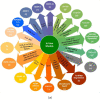An Evidence-Based Systematic Review of Human Knee Post-Traumatic Osteoarthritis (PTOA): Timeline of Clinical Presentation and Disease Markers, Comparison of Knee Joint PTOA Models and Early Disease Implications
- PMID: 33671471
- PMCID: PMC7922905
- DOI: 10.3390/ijms22041996
An Evidence-Based Systematic Review of Human Knee Post-Traumatic Osteoarthritis (PTOA): Timeline of Clinical Presentation and Disease Markers, Comparison of Knee Joint PTOA Models and Early Disease Implications
Abstract
Understanding the causality of the post-traumatic osteoarthritis (PTOA) disease process of the knee joint is important for diagnosing early disease and developing new and effective preventions or treatments. The aim of this review was to provide detailed clinical data on inflammatory and other biomarkers obtained from patients after acute knee trauma in order to (i) present a timeline of events that occur in the acute, subacute, and chronic post-traumatic phases and in PTOA, and (ii) to identify key factors present in the synovial fluid, serum/plasma and urine, leading to PTOA of the knee in 23-50% of individuals who had acute knee trauma. In this context, we additionally discuss methods of simulating knee trauma and inflammation in in vivo, ex vivo articular cartilage explant and in vitro chondrocyte models, and answer whether these models are representative of the clinical inflammatory stages following knee trauma. Moreover, we compare the pro-inflammatory cytokine concentrations used in such models and demonstrate that, compared to concentrations in the synovial fluid after knee trauma, they are exceedingly high. We then used the Bradford Hill Framework to present evidence that TNF-α and IL-6 cytokines are causal factors, while IL-1β and IL-17 are credible factors in inducing knee PTOA disease progresssion. Lastly, we discuss beneficial infrastructure for future studies to dissect the role of local vs. systemic inflammation in PTOA progression with an emphasis on early disease.
Keywords: Bradford Hill; IL-17; IL-1β; IL-6; TNF-α; acute; articular cartilage; cartilage; cartilage repair; chondrocyte; chronic; clinical; complement; early PTOA; early disease; immunomodulation; in vitro models; inflammation; inflammatory cytokines; injury; knee joint; knee trauma; osteoarthritis; post-traumatic osteoarthritis; subacute; synovial fluid.
Conflict of interest statement
The authors declare no conflict of interest.
Figures



References
Publication types
MeSH terms
Substances
LinkOut - more resources
Full Text Sources
Other Literature Sources
Medical

